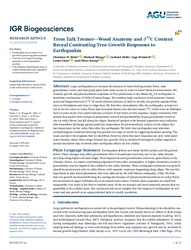Trees Talk Tremor—Wood Anatomy and δ13C Content Reveal Contrasting Tree‐Growth Responses to Earthquakes
DOI: https://doi.org/10.1029/2021JG006385
Persistent URL: http://resolver.sub.uni-goettingen.de/purl?gldocs-11858/9728
Persistent URL: http://resolver.sub.uni-goettingen.de/purl?gldocs-11858/9728
Mohr, Christian H.; Manga, Michael; Helle, Gerhard; Heinrich, Ingo; Giese, Laura; Korup, Oliver, 2021: Trees Talk Tremor—Wood Anatomy and δ13C Content Reveal Contrasting Tree‐Growth Responses to Earthquakes. In: Journal of Geophysical Research: Biogeosciences, Band 126, 10, DOI: 10.1029/2021JG006385.
 |
Dokument öffnen: |
Large earthquakes can increase the amount of water feeding stream flows, raise groundwater levels, and thus grant plant roots more access to water in water‐limited environments. We examine growth and photosynthetic responses of Pine plantations to the Maule Mw 8.8 earthquake in headwater catchments of Chile's Coastal Range. We combine high‐resolution wood anatomic (lumen area) and biogeochemical (δ13C of wood cellulose) proxies of daily to weekly tree growth sampled from trees on floodplains and close to ridge lines. We find that, immediately after the earthquake, at least two out of six tree trees on valley floors had increased lumen area and decreased δ13C, while trees on hillslopes had a reverse trend. Our results indicate a control of soil water on this response, largely consistent with models that predict how enhanced postseismic vertical soil permeability causes groundwater levels to rise on valley floors, but fall along the ridges. Statistical analysis with boosted regression trees indicates that streamflow discharge gained predictive importance for photosynthetic activity on the ridges, but lost importance on the valley floor after the earthquake. We infer that earthquakes may stimulate ecohydrological conditions favoring tree growth over days to weeks by triggering stomatal opening. The weak and short‐lived signals that we identified, however, show that such responses are only valid under water‐limited, rather than energy‐limited tree, growth. Hence, dendrochronological studies targeted at annual resolution may overlook some earthquake effects on tree vitality. Plain Language Summary:
Earthquakes deform and shake Earth's surface and the ground below. These changes may affect groundwater flow. Groundwater level may rise in the valley bottom and drop along higher elevated ridges. Trees depend on such groundwater resources, particularly in dry climates. Hence, we expect contrasting responses of trees after earthquakes: at higher elevations, access to groundwater may be impeded, but enabled in the valley bottoms. Thus, earthquake‐enhanced tree growth should be pronounced only on valley floors, with opposite responses happening along ridges. We test this hypothesis in pine forest plantations that were affected by the 2010 Maule earthquake, Chile. We find that tree growth increased following the earthquake because of enhanced photosynthesis on valley floors, but decreased on upper hillslopes due to increased water stress. Overall, these responses are small but measurable. Our study is the first to combine state‐of‐the‐art isotopic and wood anatomic proxies that we quantified at the cellular scale. Our results provide novel insights into the impacts of earthquakes on soil water and tree growth at an unprecedented daily to weekly resolution. Key Points:
Earthquakes may stimulate tree growth by promoting photosynthesis.
Direction of tree growth change depends on local topographic position.
First dendroecohydrological study to explore earthquake‐water‐vegetation interactions at scale of cells.
Statistik:
ZugriffsstatistikSammlung:
This is an open access article under the terms of the Creative Commons Attribution License, which permits use, distribution and reproduction in any medium, provided the original work is properly cited.

